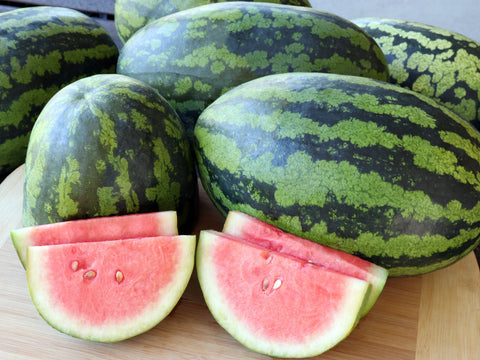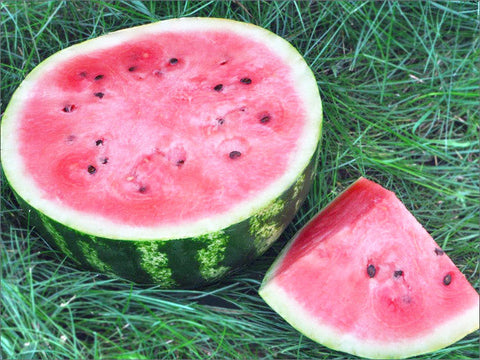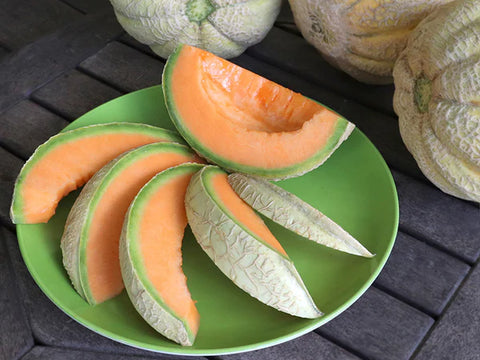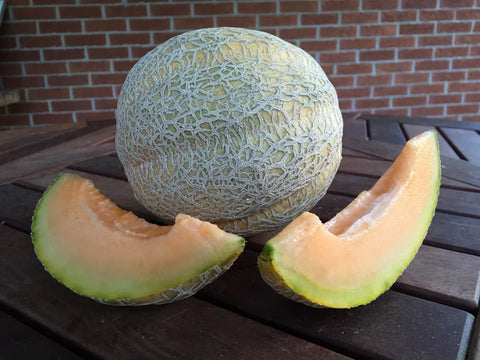Can you imagine a world without the sweet, juicy, late-summer-reminiscent fruits of your childhood? There are two main types of melons: "Muskmelons” and "Watermelons.” Although folks may confuse them, they are quite distinct and are actually two different species! That’s why we’ve divided this resource into two sections, one covering Muskmelons and the other Watermelons.
Pictured: Emerald Gem Melon (click for seeds)
What Are Muskmelons?
A muskmelon, such as cantaloupe and honeydew, is a type of fruit belonging to the Cucurbitaceae family, prized for its sweet and fragrant flesh. These melons are commonly sliced and served in fruit salads and smoothies, or eaten on their own for their juicy, refreshing taste. Muskmelons range in flavor from mild and sugary to fruity and aromatic!
What Are Watermelons?
A watermelon is a large, refreshing fruit with green skin and juicy, sweet, pink or red flesh that is often enjoyed in slices or chunks, particularly during hot summer months. Watermelons come in various shades of pink, orange, and yellow and are known for their sweet, mild, yet hydrating flavor, which is perfect for a hot summer's day.
Pictured: Trifecta Melon (click for seeds)
Why Grow Melons?
- They’re delicious!
- They’re nutritious!
- They’re refreshing ~ a perfect late-summer snack!
Industrial agriculture melons pale in flavor and texture compared to heirloom melons - fortunately, you can experience the full eating experience that melons have to offer by growing your own!
Pictured: Pride of Wisconsin Melon (click for seeds)
Growing Muskmelons & Watermelons
General Growing Instructions
All melons are frost-sensitive and need warm days to grow, thrive, and ripen. Melons need bright light to grow and thrive.
☀️ Outdoor plating: If planted outdoors, they must be planted in a full-sun location (at least 8 hours of direct sunlight per day).
💡 Indoor planting: If you plan to start seeds indoors, be sure to provide them with a high-quality light source such as T5 fluorescent or High-Pressure Sodium. Ideally, provide 16 hours of light daily (use a timer). If you use a light fixture, be sure to follow the instructions regarding the minimum distance between plants and light bulbs because too close will burn plants. Provide air circulation with a small oscillating fan set to low-blowing air between your plants and the light.
📝Instructions For Growing Muskmelons 📝
Starting Muskmelon Seeds
You can start growing Muskmelons seeds indoors or outdoors. Learn more about these options:
Starting muskmelon seeds indoors:
If you are going to start Muskmelon seeds inside, be sure to use a high-quality light source - see General Growing Instructions for Muskmelons and Watermelons above. Follow these tips:
- Start seeds indoors around 5/1.
- Sow seeds in 3” biodegradable pots into a good seed starting mix – we recommend Vermont Compost’s Fort Lite mix (the reason to use biodegradable pots is that melons don’t like their roots disturbed during planting)
- The ideal temperature for germination is 85-95° (use a heating mat).
- Melon seedlings are sensitive to damping off fungus, so keep seeds on the drier side and use a fan (set to low) to provide good air circulation.
- Days to germination: 4-5.
- After germination (once two leaves appear) grow plants at 72°.
- Do not let the plants become pot-bound in their pots.
Prepare Muskmelon Plants For Planting (aka “Hardening Off”):
Begin to harden off plants around May 25th. You should be sure to harden-off your plants before planting them outside. This process takes at least one week and is necessary to acclimate your “wimpy” indoor-grown seedlings to new outdoor conditions (wind, strong sunlight, and temperature fluctuations)
To harden off muskmelon plants:
- Start by placing your plants outside in a sunny location for two hours, then put them back under the indoor lights.
- Each day, increase the amount of time (by 1.5 hours) that the plants spend in the sun until they spend all day and night outside.
- Alternatively, place plants outdoors in a protected (non-windy) location where they will receive only two hours of morning sunlight and be in the shade for the rest of the day.
- Bring them in at night for the first few nights.
- Each day, place your plants in a location that will receive more sunlight and wind so that in seven days, they will be spending all day and night outside (this can be accomplished by locating them farther and farther away from the source of shade/wind protection)
- Transplant them outdoors (around 6/1); plant pot & all – do not disturb roots.
Direct sow muskmelon seeds outdoors:
Direct sow seeds outdoors (1/2” deep) around 6/1, keeping seeds moist until germination.
Soil: Melons want lots of organic matter (compost and/or decomposed manure). They prefer well-drained soil.
Light: Plant melons in full sun. Full sun requires direct light at least six hours/day; 8 - 10 hours per day is preferable.
Spacing: Melons tend to take up quite a lot of space; we’d recommend planting at least 3 feet apart.
Water: Water plants regularly (we recommend drip irrigation/soaker hoses).
Pests:
- Protect outdoor germinating seeds from slugs (use phosphate-based organic slug bait).
- Protect plants from cucumber beetles by covering seeds/seedlings with row cover fabric at planting.
- Protect plants from groundhogs and deer with repellants or fencing.
- Protect ripening melons from raccoons.

Pictured: Watermelons
📝 Instructions For Growing Watermelons 📝
Starting Watermelon Seeds
Watermelons are heat-loving plants and must be planted outdoors after summer weather has settled in (early June). You can start seeds indoors or outdoors (but will likely have better results starting seeds indoors if you follow these instructions)
Starting watermelon seeds indoors:
If you are going to start Muskmelon seeds inside, be sure to use a high-quality light source (see General Growing Instructions for Muskmelons and Watermelons above).
- Start seeds indoors around 5/7.
- Sow seeds in 3” biodegradable pots into a good seed starting mix – we recommend Vermont Compost’s Fort Lite mix. (The reason to use biodegradable pots is that melons don’t like their roots disturbed during planting)
- The ideal temperature for germination is 85-95° (use a heating mat).
- Watermelon seedlings are sensitive to damping off fungus so keep soil lightly moist but not too wet and use an oscillating fan (set to low) to provide good air circulation.
- Ideal days to germination is 4-5.
- Once two leaves appear, grow plants at a cooler temperature (around 72°).
- Do not let plants become pot-bound in their pots.
Prepare Watermelon Plants For Planting (aka “Hardening Off”):
Begin to harden off watermelon plants around early June and make sure you harden-off your plants before planting them outside. This process takes at least one week and is necessary to acclimate your “wimpy” indoor-grown seedlings for new outdoor conditions (wind, strong sunlight, and temperature fluctuations).
To harden off watermelon plants:
- Start by placing your plants outside in a sunny location for 2 hours, then put them back under the indoor lights.
- Each day, increase the amount of time (by 1.5 hours) that the plants spend in the sun until they spend all day and night outside.
- Alternatively, place plants outdoors in a protected (non-windy) location where they will receive only 2 hours of morning sunlight and be in the shade for the rest of the day.
- Bring them in at night for the first few nights. Each day, place your plants in a location that will receive more sunlight and wind so that in 7 days, they will be spending all day and night outside (this can be accomplished by locating them farther and farther away from the source of shade/wind protection)
- Transplant them outdoors (in early June); plant pot & all – do not disturb roots.
Direct sow watermelon seeds outdoors:
Direct sow seeds outdoors once warm summer weather has arrived (minimum soil temp of 65° in early June). Keep seeds moist until germination.
Soil: Melons want lots of organic matter (compost and/or decomposed manure). They prefer well-drained soil.
Light: Plant melons in full sun.
Spacing: Watermelons are very large, vining plants and need lots of room to sprawl. Although it depends on the variety of watermelon, as a general guideline, we’d recommend planting your seeds at least 4-6 feet apart, depending on the variety.
Water: Water plants regularly (we recommend drip irrigation/soaker hoses).
Pests:
- Protect outdoor germinating seeds from slugs (use phosphate-based organic slug bait).
- Protect plants from cucumber beetles by covering seeds/seedlings with row cover fabric at planting.
- Protect plants from groundhogs and deer with repellents or fencing d. Protect ripening melons from raccoons

Harvesting Melons: How do you know when they are ripe?
While muskmelons and watermelons will ripen somewhat off the vine they will develop their full flavor when fully ripened on the vine.
Muskmelons: harvest cantaloupes when fruit turn from green to orange and are easily removed from the plant.
Watermelons: Check for three signs of watermelon ripeness:
- When a spot on the bottom of the fruit begins to turn from white to yellow
- The tendril near the main stem has turned brown
- The fruit has a hollow sound when knocked or flicked. Do not let fruit over-ripen on the vine.



